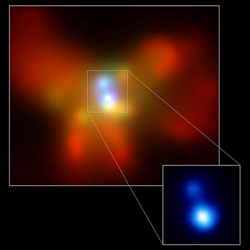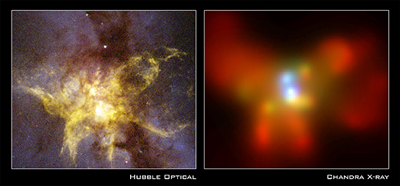November 19, 2002
RELEASE: 02-222
For the first time, scientists have proof two supermassive black holes exist together in the same galaxy, thanks to data from NASA's Chandra X-ray Observatory. These black holes are orbiting each other and will merge several hundred million years from now, to create an even larger black hole resulting in a catastrophic event that will unleash intense radiation and gravitational waves.
The Chandra image reveals that the nucleus of an extraordinarily bright galaxy, known as NGC 6240, contains not one, but two giant black holes, actively accreting material from their surroundings. This discovery shows that massive black holes can grow through mergers in the centers of galaxies, and that these enigmatic events will be detectable with future space-borne gravitational wave observatories.
"The breakthrough came with Chandra's ability to clearly distinguish the two nuclei, and measure the details of the X-radiation from each nucleus," said Guenther Hasinger, of the Max Planck Institute for Extraterrestrial Physics in Germany, a coauthor of an upcoming Astrophysical Journal Letters paper describing the research. "These cosmic fingerprints revealed features characteristic of supermassive black holes -- an excess of high-energy photons from gas swirling around a black hole, and X-rays from fluorescing iron atoms in gas near black holes," he said.
Previous X-ray observatories had shown that the central region produces X-rays, while radio, infrared and optical observations had detected two bright nuclei, but the nature of this region remained a mystery. Astronomers did not know the location of the X-ray source, or the nature of the two bright nuclei.
"With Chandra, we hoped to determine which one, if either, of the nuclei was an active supermassive black hole," said Stefanie Komossa, also of the Max Planck Institute, lead author of the paper on NGC 6240. "Much to our surprise, we found that both were active black holes!"
At a distance of about 400 million light years, NGC 6240 is a prime example of a massive galaxy in which stars are forming at an exceptionally rapid rate due to a recent collision and subsequent merger of two smaller galaxies. Because of the large amount of dust and gas in such galaxies, it is difficult to peer deep into their central regions with optical telescopes. However, X-rays emanating from the galactic core can penetrate the veil of gas and dust.
"The detection of a binary black hole supports the idea that black holes can grow to enormous masses in the centers of galaxies by merging with other black holes," said Komossa. "This is important for understanding how galaxies form and evolve," she said.
Over the course of the next few hundred million years, the two black holes in NGC 6240, which are about 3000 light years apart, will drift toward one another and merge to form an even larger supermassive black hole. Toward the end of this process an enormous burst of gravitational waves will be produced several hundred million years from now.
These gravitational waves will spread through the universe and produce ripples in the fabric of space, which would appear as minute changes in the distance between any two points. NASA's planned space-based detector, LISA (Laser Interferometer Space Antenna), will search for gravitational waves from massive black-hole mergers. These events are estimated to occur several times each year in the observable universe.
"This is the first time we see a binary black hole in action, the smoking gun for something that will become a major gravitational wave burst in the future," said Hasinger.
Chandra observed NGC 6240 for 10.3 hours with the Advanced CCD Imaging Spectrometer (ACIS). Other members of the team are Vadim Burwitz and Peter Predehl of the Max Planck Institute, Jelle Kaastra of the Space Research Organization Netherlands and Yasushi Ikebe of the University of Maryland in Baltimore.
NASA's Marshall Space Flight Center in Huntsville, Ala., manages the Chandra program for the Office of Space Science, Washington, and TRW, Inc., Redondo Beach, Calif., is the prime contractor for the spacecraft. The Smithsonian's Chandra X-ray Center controls science and flight operations from Cambridge, Mass.
MEDIA CONTACTS
Don Savage, Public Affairs Office
NASA Headquarters, Washington D.C.
Phone: 202-358-1727
Steve Roy
Marshall Space Flight Center, Huntsville, AL
Phone: 256-544-6535
Megan Watzke
Chandra X-ray Observatory Center, CfA, Cambridge, MA
Phone: 617-496-7998
cxcpress@cfa.harvard.edu




